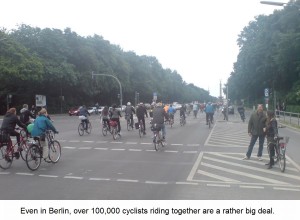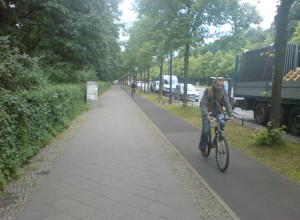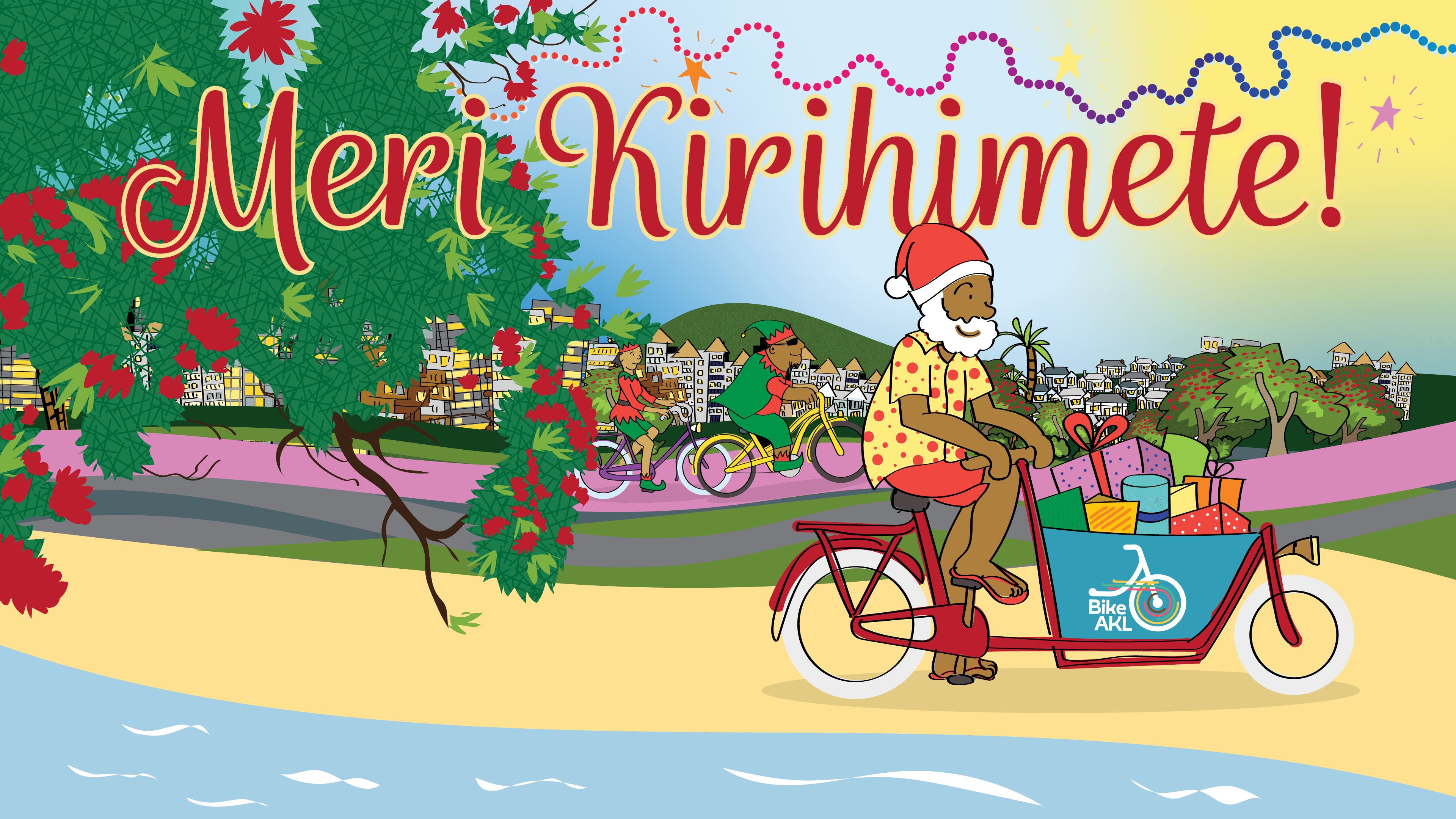[After a long absence, I got the chance to visit Europe again. Having become a cycling advocate in NZ in the meantime, I was keen to look closer at what I had previously taken for granted. In this series, I will talk about cycling in four cities I visited – Berlin, Warsaw, Paris and London.]
BERLIN
 First impressions: Cycling in Berlin is like the city itself: Busy, mainstream, fun – with a quirky edge.
First impressions: Cycling in Berlin is like the city itself: Busy, mainstream, fun – with a quirky edge..
Coming into Berlin, the first cycling impressions on leaving the subway stations are all the bikes parked everywhere. Not only numbers and numbers of private bikes – within 50m of our inner city hotel, we have 5 (!) different hire bike options. Two city-wide networks, as well as two hotels (including ours) and a bike shop – all hiring out two-wheelers.
.
Soon after, we are walking through the back streets of the “Scheunenviertel” neighbourhood in former East Berlin, close to where the wall once ran. While I and my girlfriend hungrily search for a dinner place, I do an impromptu traffic survey – but after five minutes I stop: I have seen over 15 cyclists pass me, and only 4 or 5 moving cars. It’s not like cars are absent – in fact the streets are parked full with thousands of them. But they seem more like abandoned pieces of furniture – unmoving, as if the residents had bought the cars, then forgotten them – while bikes, and legs in general, are what really moves people around here.
.
 Perceived mode share: Cyclists everywhere – around 10-15% (Auckland around 1-2%)
Perceived mode share: Cyclists everywhere – around 10-15% (Auckland around 1-2%).
Cycling is a big time thing in Berlin, that much is easy to see for the casual visitor. With cycling in Germany making up around 10% of all trips, Berlin would actually sit well in the trend.
.
However, a quick glance into the news shows that Berlin is also suffering from the same conflicts that Auckland does: newspapers shout about “rising cycling injuries”, editorials complain about cyclists not obeying the road rules, cyclists complain about bad infrastructure. So far, so known, so much for a dash of cold water on my enthusiasm – obviously even cities with busy cycle cultures don’t lose those perpetual problems, the constant little dramas just play out on a more level playing field.
.

But I can’t really feel down on cycling in a city where sitting down on any random cafe chair or park bench, I can watch cyclists go by in droves.
.
And then suddenly I have to jump up, camera in hand, and run to the nearby main street – because we just happen to be in Berlin on the day the local cycling club happened to organise a “Star Ride” (where group rides start out from all parts of town to converge on a central goal). A ride that attracted around 150,000 (!) cyclists. Some of the main routes were still full of streaming cyclists two hours later when we left the area. Wow.
.
Typical cyclists (cycle style): Stylish. Often VERY stylish – your typical Berliner is pretty dapper already, and he / she sees no reason not to keep that up on the bike.
.
Without a helmet law, and with cycling a very much accepted part of daily life, cyclists in Berlin run the whole range, from your business chap off to a meeting to the young designer out for a coffee to people getting groceries. Spotting someone in Lycra was rare enough to make my girlfriend remark on the occasion that she could still count them on one hand, even though we had been in Germany for several days by then. With or without that fact, Berlin wins the cycle-chic competition hands down.
.

Cargo bikes are (relatively) rare – though I saw a number of “professional” bikes, i.e. mobile sale stands hawking food or similar – but lots of parents carry kids’ seats on their bikes, or tow the tykes behind in little buggies like at the right.
.
My girlfriend spotted (but sadly didn’t photograph) an adorable situation where she saw a father riding home with his little girl. She sitting on her little bike – with her bike in the loading bay of his cargo bike. Go faster, daddy!
.
Cycle infrastructure: Mixed. Disjointed. Not as much as expected. And yet it works.
.

In some ways, Berlin was a bit of an eye-opener for me as a cycle advocate. I would have expected that a city with so much cycling would have more obvious cycle infrastructure, and be better about linking it up. Cycleways and cycle lanes in places like Paris also seem much more visible (more on that in a later post) – yet Berlin simply rides on.
.
The fact that a great cycle city doesn’t automatically imply consistent cycle infrastructure was brought home to me when we went cycling on rented bikes on our second day. After leaving the Scheunenviertel proper (where they have a 10 km/h speed limit very conducive to relaxed cycling!) we rode towards the Tiergarten Park – and soon ended up on a busy arterial road without cycle facilities. Since my better half isn’t confident riding in heavy traffic, we first diverted onto the footpath, then eventually even got off and pushed some distance, until we ended up in more friendly territory again.
.
That could have probably been avoided with local knowledge, or a good cycle route map (we just went for it) – but it showed that not all is bliss, and yes, cycle facilities still do suddenly end when you need them most, a problem we know all too well from Auckland.
.

Once in areas with good cycleways, riding was very easy. Berlin’s squares and streets / boulevards are often very wide, with lots of opportunity for formal or informal cycling space.
.
Cycling in parks like the Tiergarten was particularly pleasant – walking paths, while often not asphalted, tend to be very wide, and cycling is allowed pretty much everywhere. The same seems to apply for most of the squares, and semi-pedestrianised areas of the city.
.
I did see a few instances of clever cycle infrastructure, for example a bike street (basically a traffic-calmed side street) crossing an arterial road with a dedicated signal crossing, or a nice way of incorporating “hook turn” facilities so cyclists don’t have to wait in the middle of the road.
.
.
But in particular the low-level “infrastructure” of slow-speed zones impressed me. Of course as a traffic engineer I have always known (and supported for CAA) the concept of slow[er]-speed zones as a safety and cycling-friendly feature – but having whole suburbs with 10 km/h speed limits, where “slowly slowly” is the rule, makes for a totally different city feel.
.
Public bike hire system: What bike hire system? There’s loads of them!
.

Hiring a bike in Berlin is easy – unless you get confused by the amount of choice. With cycling such an obvious way to get around, lots of hotels and even restaurants have jumped onto the bandwagon. Walking through the inner suburbs around the centre of the city, you’ll see racks and racks full of hotel rental bikes, all advertised both for hotel visitors as well as “drop-ins”.
.
Of course, with these systems, you have to return the bikes to where you rented them from in the first place. But then, there’s also more wide-ranging systems. These include 300 bikes of the German original version of
NextBikes (Auckland’s currently inactive public bike system), as well as, last and largest, the red “
Call-a-bike” bikes.
.
Operated by Deutsche Bahn, Germany’s national rail carrier, they are closest to Berlin’s “official” public bike hire system. They have their bikes in about 10 German cities (plus at main train stations in further cities), and currently operate around 80 bike rental stations in Berlin – though the system is still small in numbers compared to systems in Paris or London.
.
I will do a separate blog post comparing the various public bike hire systems I tried out in Europe, so I’ll just say here that while the many different options in Berlin prevent public bikes from being as highly visible as they are in Paris or London – with their unified branding and constant presence – hiring a bike in Berlin is pretty easy.
.
The verdict: It’s great, and it’s as much about the culture as about the infrastructure
.
Berlin obviously doesn’t get it’s many cyclists from it’s brand-spanking perfect infrastructure. The city administration is deeply in debt – in fact, Berlin’s mayor famously called the city “poor but sexy” – and while the roads and paths weren’t too badly maintained, I expect the budget for new and improved cycleways is pretty limited (Germany-wide too, the cycling budget remains surprisingly low – federal funds for cycleways make up barely a percent of the traffic funds).
.

So obviously, enthusiasm for cycling, and motorist attitude towards cyclists, counts for a lot in achieving or maintaining a wide population on bikes. The experience of Berlin hasn’t made me dismissive of good infrastructure at all – instead it makes me hopeful that even with an incomplete, partially sub-standard cycle network, a city can be great for cycling. Work from what you have.
.
Berlin is gross, und ich bin klein*, but that doesn’t have to discourage any cyclist.
.
* “Berlin is big and I am small” – the slogan of a cute little penguin (icon of a local design company) we saw & loved in Berlin.
.
 First impressions: Cycling in Berlin is like the city itself: Busy, mainstream, fun – with a quirky edge.
First impressions: Cycling in Berlin is like the city itself: Busy, mainstream, fun – with a quirky edge. But I can’t really feel down on cycling in a city where sitting down on any random cafe chair or park bench, I can watch cyclists go by in droves.
But I can’t really feel down on cycling in a city where sitting down on any random cafe chair or park bench, I can watch cyclists go by in droves. Cargo bikes are (relatively) rare – though I saw a number of “professional” bikes, i.e. mobile sale stands hawking food or similar – but lots of parents carry kids’ seats on their bikes, or tow the tykes behind in little buggies like at the right.
Cargo bikes are (relatively) rare – though I saw a number of “professional” bikes, i.e. mobile sale stands hawking food or similar – but lots of parents carry kids’ seats on their bikes, or tow the tykes behind in little buggies like at the right. In some ways, Berlin was a bit of an eye-opener for me as a cycle advocate. I would have expected that a city with so much cycling would have more obvious cycle infrastructure, and be better about linking it up. Cycleways and cycle lanes in places like Paris also seem much more visible (more on that in a later post) – yet Berlin simply rides on.
In some ways, Berlin was a bit of an eye-opener for me as a cycle advocate. I would have expected that a city with so much cycling would have more obvious cycle infrastructure, and be better about linking it up. Cycleways and cycle lanes in places like Paris also seem much more visible (more on that in a later post) – yet Berlin simply rides on. Once in areas with good cycleways, riding was very easy. Berlin’s squares and streets / boulevards are often very wide, with lots of opportunity for formal or informal cycling space.
Once in areas with good cycleways, riding was very easy. Berlin’s squares and streets / boulevards are often very wide, with lots of opportunity for formal or informal cycling space. Hiring a bike in Berlin is easy – unless you get confused by the amount of choice. With cycling such an obvious way to get around, lots of hotels and even restaurants have jumped onto the bandwagon. Walking through the inner suburbs around the centre of the city, you’ll see racks and racks full of hotel rental bikes, all advertised both for hotel visitors as well as “drop-ins”.
Hiring a bike in Berlin is easy – unless you get confused by the amount of choice. With cycling such an obvious way to get around, lots of hotels and even restaurants have jumped onto the bandwagon. Walking through the inner suburbs around the centre of the city, you’ll see racks and racks full of hotel rental bikes, all advertised both for hotel visitors as well as “drop-ins”. So obviously, enthusiasm for cycling, and motorist attitude towards cyclists, counts for a lot in achieving or maintaining a wide population on bikes. The experience of Berlin hasn’t made me dismissive of good infrastructure at all – instead it makes me hopeful that even with an incomplete, partially sub-standard cycle network, a city can be great for cycling. Work from what you have.
So obviously, enthusiasm for cycling, and motorist attitude towards cyclists, counts for a lot in achieving or maintaining a wide population on bikes. The experience of Berlin hasn’t made me dismissive of good infrastructure at all – instead it makes me hopeful that even with an incomplete, partially sub-standard cycle network, a city can be great for cycling. Work from what you have.




